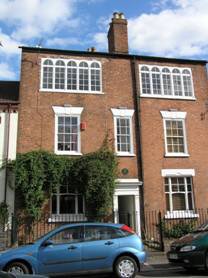

The Weavers Cottages
Practically every type of industry that has been carried out in Coventry has also been tried in Earlsdon, with varying degrees of success; so not surprisingly when the new residents began to move into Earlsdon in 1852 there was among them a small number of people engaged in the ribbon weaving industry. Beginning in 17th Century to replace the failing cloth trade, it was at the time the most important in the city, employing some 10,000 people and producing more ribbon than any other area of the country. The growing industry drew many weavers from other areas into the city seeking work and causing dreadful overcrowding. It was a poorly paid job and wives and children of quite a young age, had to help with the work so enough could be earned to feed and clothe the family. Obviously not many would be able to finance a move to prestigious Earlsdon, most of those who were moving in were employed in the much better paid watchmaking industry. A few families rented their homes, but two were able to buy plots and have houses built on them. These were, and they are still lived in today, on Berkeley Road South, or Cromwell Street as it was then known. They are typical weaver's three storey homes with the usual topshops where, to take the weight of heavy looms, the floors had to be reinforced. Needing as much daylight as possible for their close work, just as watchmakers did, they had large windows put in their top shops; but whereas watchmakers had theirs placed discreetly at the rear of the house, the not so fussy weavers had theirs facing the front street, so that it was obvious to every passer by what their business was.
The two houses had obviously been built together, so it is very likely that the purchasers, George Pool and David Green, were friends; both appeared in the 1861 census. By this time, George was 46, married to Anne with 2 children, Sarah aged 14, apprenticed to the weaving trade, and William aged 5. They also had a girl, Elizabeth Gee, probably a relative living with them, aged 11 and also apprenticed, probably to George. David Green next door, was aged 49, married to Elizabeth, with 4 children, William aged 20 and Lydia aged 11, both ribbon weavers and Sarah and Ada aged 14 and 11. Apart from these two families who worked in their own top shops, there were 26 others on the estate working in the trade, some at least of whom worked in a specially built shed at the rear of the three storey houses on the other side of the road. But dark days were ahead for the weavers. When they first moved onto the new estate in the !850s, they must have been reasonably confident about their future, although all through the decade there had been problems. Antagonism against factory work with its restrictions and long hours without respite and appalling low pay for all, caused bitter strikes. There was also the ongoing fickleness of fashions with feathers in some years replacing ribbon. However this was nothing in comparison to the effect of the Governments removal of the import tariff on ribbons in 1860 under the Cobden Treaty. Up until this point there had been a tariff of 15% on French ribbons which had made them much more expensive than the Coventry ones. Now of course they were more affordable, were also more fashionable. So the Coventry trade slumped and the weavers suffered. Indeed many were so reduced to almost starvation that public money had to be raised for their relief and a soup kitchen opened in St Mary's Hall. Some men were set to work clearing Hearsall Common for a shilling a day just to give them employment. Naturally the Earlsdon weavers were affected. They had been rather looked down on by the more affluent watchmakers, but it is hoped that now there was commiseration at their plight. By 1868 they had nearly all left and gone back to cheaper housing in the city, and by 1871 only David Ward and his family, who had replaced David Green, still remained and still worked at his weaving. They also soon departed and the little ribbon weaving shed was closed and deserted, although ten years later it was to be resurrected and put to good use again. The two houses with their top shops were soon occupied by watchmakers and it was soon forgotten that there had ever been the clackety-clack of looms weaving silk ribbons in Cromwell Street. |

